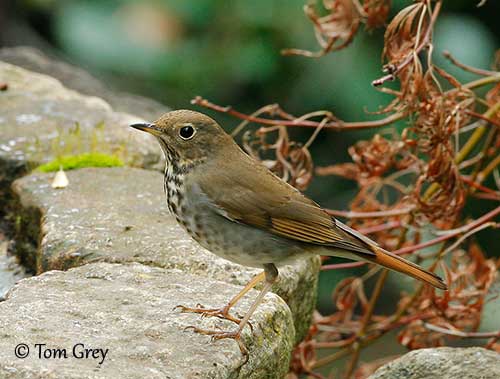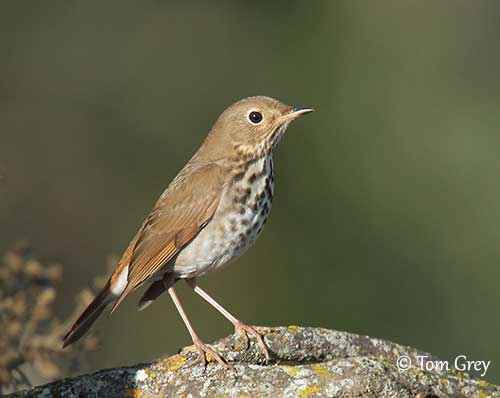
Fr: Grive solitaire
Ang: Hermit Thrush
All: Einsiedlerdrossel
Esp: Zorzalito Colirrufo
Ita: Tordo di Pallas
Nd: Heremietlijster
Sd: eremitskogstrast
Photographers:
John Anderson
John Anderson Photo Galleries
Tom Grey
Tom Grey's Bird Pictures & Tom Grey's Bird Pictures 2
Tom Merigan
Tom Merigan’s Photo Galleries
Text by Nicole Bouglouan
Sources:
HANDBOOK OF THE BIRDS OF THE WORLD Vol 10 by Josep del Hoyo-Andrew Elliott-David Christie - Lynx Edicions - ISBN: 8487334725
THRUSHES by Peter Clement and Ren Hathway – HELM - ISBN: 0713639407
All About Birds (Cornell Lab of Ornithology)
Wikipedia, the free encyclopaedia
What Bird-The ultimate Bird Guide (Mitchell Waite)
Neotropical Birds – Cornell Lab of Ornithology
The Birds of North America online
Bird Web (Seattle Audubon Society)
ONEIDA - The Legend of the Hermit Thrush
Hermit Thrush
Catharus guttatus
Passeriformes Order – Turdidae Family
INTRODUCTION:
The Hermit Thrush is a North American species and the only thrush seen in winter on this continent. It breeds in Alaska, Canada and USA, and winters in W and S USA and in Mexico.
It usually frequents coniferous, deciduous or mixed forests, and mainly the forest floor where it forages, searching for insects and berries. This species nests in a bulky structure on the ground under trees and bushes, or sometimes up to 3-10 metres in trees.
The Hermit Thrush has eight subspecies divided into three main groups with the birds of Pacific states, the birds of interior mountains West and the Eastern birds. They differ in body size and intensity of plumage colours.
The Hermit Thrush is described as fairly common throughout its range, but it is affected by habitat degradation. However, the population is increasing in several states.

DESCRIPTION OF THE BIRD:
Biometrics:
Length: 16-18 cm
Weight: 18-37 g
The Hermit Thrush of nominate race has grey-brown or tinged olive upperparts and head. The rump is mostly brown, whereas the tail is chestnut. On the upperwing, the feather edges are brown.
The underparts are white with buff wash on the breast, and dark brown spots on sides of lower neck and breast. The flanks are mostly pale greyish. The underwing is deep brown and the flight-feathers have whitish bases, forming broad pale and dark stripes visible in flight.
The bill is dark horn with yellowish or flesh-pink base of lower mandible. The eyes are dark brown. Legs and feet are flesh-pink.
Male and female are similar.
The juvenile resembles adults, but it has finely streaked upperparts and buffy-white underparts with barred lower breast, belly and flanks.
SUBSPECIES AND RANGE:
The Hermit Thrush has eight subspecies.
C.g. guttatus (described above) breeds in S Alaska and W Canada, and winters in W USA and N and C Mexico.
C.g. nanus breeds in coastal regions of SE Alaska and W Canada, and winters in W USA and NW Mexico.
This race is smaller and slightly darker than nominate.
C.g. slevini breeds on W coast of USA and winters in NW Mexico.
It is smaller than nominate, with paler upperparts and fewer spotting on the underparts.
These three subspecies belong to the Pacific coast “guttatus” group.
C.g. sequoiensis breeds in mountains of SW USA, also in NW and N Mexico, and winters in SC USA and N Mexico.
This race is larger than previous, with pale upperparts and larger spots below.
C.g. auduboni breeds in Rocky Mountains in WC Canada and NW USA, and winters in WC USA and Mexico S to Guatemala.
This one is the largest. It is paler and duller overall.
C.g. polionotus breeds in Rocky Mountains in NC USA and winters in W Mexico.
It is very similar to “auduboni” with duller greyish-olive upperparts and white undertail-coverts.
These three races belong to the interior mountain “auduboni” group.
C.g. faxoni breeds in EC and E Canada and E USA, and winters in SE USA and NE and EC Mexico.
This one is brightest with warmer brown upperparts and rusty edges to wing-coverts. There are two morphs, one with dull brown head but warmer upperparts, and the other race is more grey-brown.
C.g. crymophilus breeds in Newfoundland and adjacent areas, and winters in SE and SC USA.
This one has darker upperparts than “faxoni”.
Both belong to the E “faxoni” group.
HABITAT:
The Hermit Thrush breeds mainly in coniferous, deciduous and mixed forests, preferring open forest or woodland and the areas along the forest edge. The breeding habitats usually vary depending on the range, and may include woods with various tree species (spruce, sphagnum and pine), second growth with standing dead trees, wooded canyons and mountain forest.
During winter and on migration, it frequents a large variety of woodland.
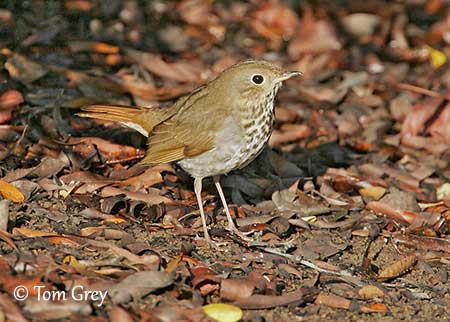
CALLS AND SONGS: SOUNDS BY XENO-CANTO
The Hermit Thrush gives frequently a variety of “tuck” calls, or “chuck”, “choop”, “quit” or “wit” notes.
The song is very similar to that of the Wood Thrush, a series of clear and musical phrases at different pitches, with a pipping note at the beginning, followed by two phrases with the first one longest and lowest in pitch, and the remainder clear and sweet, but fading at the end in a down-slurred flourish. This is a rich, beautiful song, sometimes mentioned in legends (see the link at the bottom of this page).
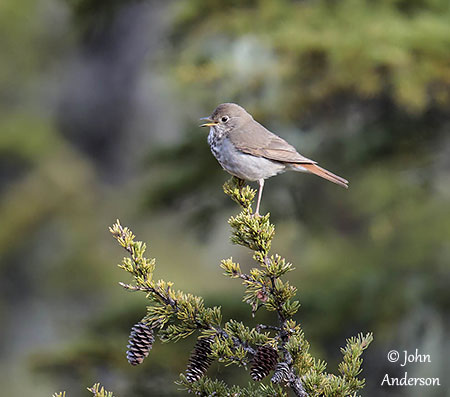
BEHAVIOUR IN THE WILD:
The Hermit Thrush feeds mainly on insects and berries. Insects include beetles, ants, caterpillars, grasshoppers, crickets and other species. It also takes spiders and earthworms.
During winter, it feeds mostly on berries of various species.
It forages primarily on the ground on the forest floor. It catches insects in the leaf-litter, in shrubs and trees, and even by hovering briefly in front of the vegetation.
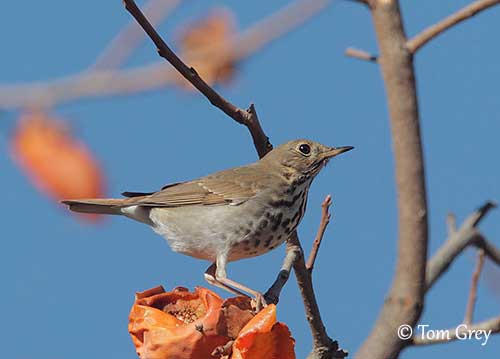
During the breeding season, the male sings in both morning and evening to defend the territory. It sings from treetops but also from lower perches.
The female builds the nest and incubates alone, but she is fed by the male during this period.
The Hermit Thrush is migratory or partial migrant, depending on the range. But they perform mainly short-distance migrations.
The flight is swift and direct with rapid wingbeats.
REPRODUCTION OF THIS SPECIES:
The breeding season takes place between late April and late August.
The Hermit Thrush female builds a bulky nest made with twigs, bark strips, dry grasses, leaves, ferns and moss. It is lined with pine needles, rootlets, willow catkins, plant fibres or fine grass.
The birds of E and N of the range nest often on the ground in natural hollow close to a hummock and hidden by overhanging branches and low vegetation.
The birds of the W range nest mostly in trees, usually conifers, between 3 and 10 metres above the ground.
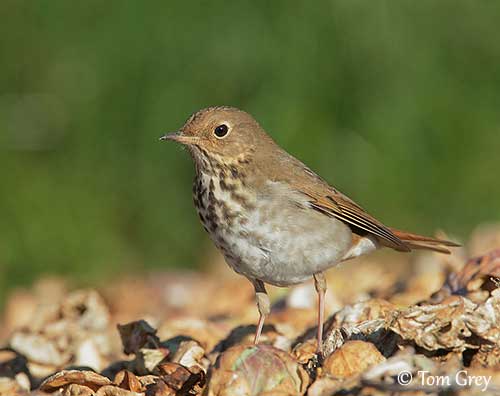
The female lays 3-5 pale blue to greenish-blue eggs, sometimes with dark markings. She incubates alone during 12-13 days, and she is fed by the male during this period. The chicks are fed by both parents, and fledge about 12 days after hatching.
This species produces one or two broods per season, sometimes three in S of the range.
PROTECTION / THREATS / STATUS:
The Hermit Thrush is described as fairly common. It is affected by degradation of the habitat through forest clearance. The nest predators probably include squirrels, chipmunks and weasels, and also the Sharp-shinned Hawk which takes the young birds.
The population is increasing significantly since several years in North America.
The Hermit Thrush is not globally threatened, and currently evaluated as Least Concern.
